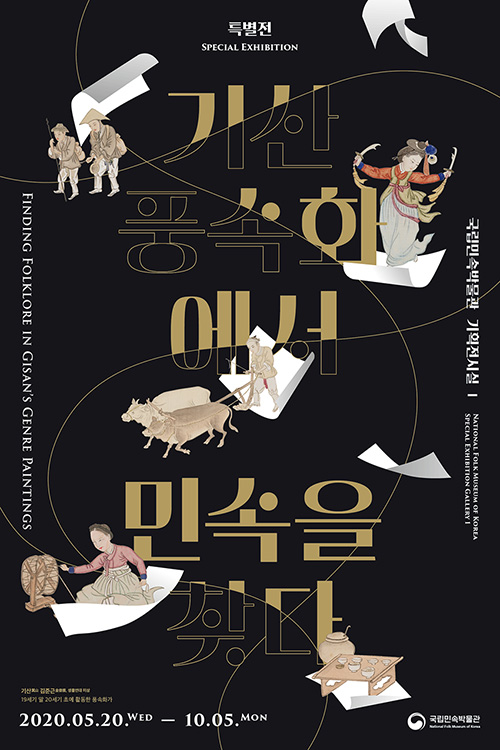Overview
National Folk Museum of Korea is pleased to present the special exhibition Finding Folklore in Gisan’s Genre Paintings to explore the depictions of Korean folk customs and their evolution over time through the genre paintings by Kim Jun-geun (dates unknown; pen name: Gisan). It goes on to examine the very nature of folklore.
Kim Jun-geun was a painter active from the late nineteenth to the early twentieth century. He never achieved the fame of Kim Hong-do or Shin Yun-bok, the two most prominent genre painters of the Joseon period. However, he painted a more diverse range of folk customs. His genre paintings are considered invaluable in that they depict livelihoods, food, clothing, housing, rituals, and games popular among Koreans from a century ago more vividly than the photography that was introduced to Korea in the late nineteenth century.
This exhibition is comprised of a prologue, two main sections, and an epilogue. The first main section entitled “Folklore Whispers” introduces genre paintings illustrating spaces of daily life, such as markets, villages, houses, and fields. It further features paintings on topics of rites of passage such as weddings and funerals, and depictions of educational and penal practices. The second section “Testifying to Folklore” examines the Korean folklore that survived or changed over the past century through the genre paintings and the objects depicted in them.
Folklore continues to evolve as times and the cultures change. This special exhibition offers visitors with an opportunity to think about the meaning of our lives and folk customs.

Part I. Folklore Whispers
This section invites viewers to look into the folk customs depicted in Gisan’s genre paintings, which are less well known to the public, from the late nineteenth century to early twentieth century. Some 150 genre paintings are presented here according to their living spaces and temporal order.
Folklore from a century ago whispers to us from these paintings with subjects ranging from markets where people and products gather and various performances take place to diverse manual industries like making hats and rites of passage such as weddings and funerals, as well as amusements and punishments.
In the paintings of A Market Broker in a Village House and Going on a Picnic are respectively shown how Koreans raised pigs at home and how people enjoyed spring by stepping on grass on the third day of the third lunar month. The figures illustrated in these genre paintings will speak to viewers in a low, soft voice about the old customs. By listening attentively and examining the paintings thoroughly, viewers will discover new and interesting traditions and grow familiar with the folklore of the time.
Kim Jun-geun (Dates Unknown; Pen Name: Gisan)
Kim Jun-geun (also known as Gisan) was a painter who worked in the late nineteenth and early twentieth century. The dates of his birth and death are unknown, and little information about him has survived.
Since many travelers, diplomats, and missionaries who visited Korea bought Gisan’s paintings, his works are actually found more in foreign countries than in Korea.
Gisan’s Genre Paintings in the Collection of MARKK (Museum am Rothenbaum – Kulturen und Künste der Welt, former Museum für Völkerkunde Hamburg) | Germany
MARKK (Museum am Rothenbaum – Kulturen und Kunste der Welt, former Museum fur Volkerkunde Hamburg), one of the major ethnology museums in Europe, was established in 1879 in Hamburg, Germany.
It houses seventy-nine genre paintings by Gisan. Among them, sixtyone paintings on silk were collected by Heinrich Constantin Eduard Meyer (1841–1926), a diplomat and merchant who founded the Sechang Yanghaeng Company in Incheon.
The other eighteen paintings on paper were donated by Nachlab W. Danzel, who served as the department head of Museum fur Volkerkunde Hamburg. However, their provenance is still unclear.
We are pleased to introduce, for the very first time in Korea, the 79 Gisan’s genre paintings from the collection of the Museum am Rothenbaum, which have returned for the exhibition 126 years after they left Korea.
Part II. Testifying to Folklore
This section explores the old folk customs depicted in Gisan’s genre paintings that either still live with us or have disappeared by examining the objects portrayed in these paintings from the late nineteenth century to early twentieth century. Some paintings feature practices that have vanished now such as women fulling cloth with clubs or items that have changed in shape and usage but whose function partially remains today like the hats for officials.
Also, they illustrate baduk(go) and janggi(Korean chess) boards, fans, and cigarettes, all of which are now made of different materials yet still used today, and traditional wedding ceremonies which continue to be performed but in different styles. The objects and folk scenes in Gisan’s works illustrate the characteristics of items that have changed in shapes and functions or the traits of rites that have transformed with the times. Viewers are invited to think about the nature of folklore by observing the changes in folk customs.
Epilogue. Folklore Changes
Folklore is transmitted but it evolves. The changes in folklore are inevitable like a generational shift. Thus, folklore does not remain in the past, but heads toward the future.
Even folk customs from just a century ago seem strange yet familiar to Koreans now. This could be explained by the cultural DNA embedded in them which enables Koreans to relate to the continuously changing but enduring folklore of Korea.



